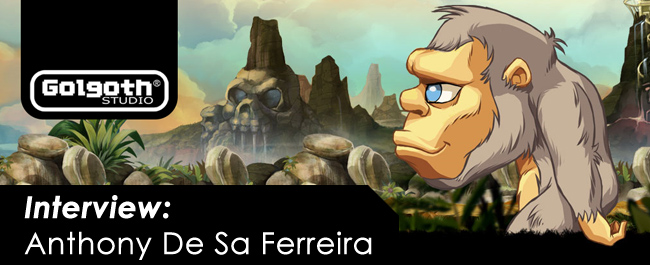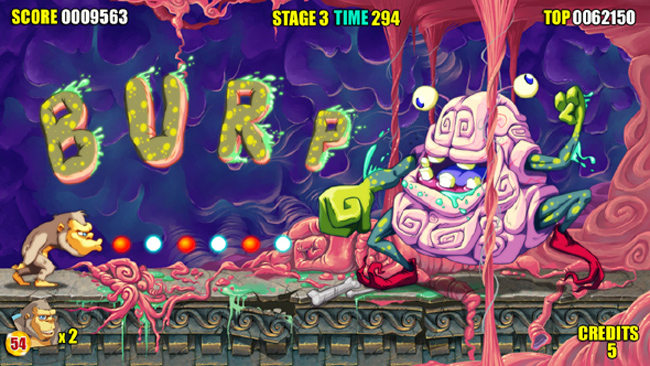
Contributed by: Toby Davis
There are always people looking for the next big thing in gaming, trying new genres or game play mechanics along the way. Sometimes these can even become groundbreaking hits. However, developers should still be allowed to create based on comfortable, established gaming conventions if a project calls for it. Recently, we were able to speak with Anthony De Sa Ferreira, Director at Golgoth Studio about that topic, as well as shedding some light on the background of their upcoming Toki re-imagining.
Toby Davis: When was your studio formed, and how were the name and logo chosen?
Anthony De Sa Ferreira: Our studio was formed in June 2008. The name of the studio is a homage to the love of Philippe Dessoly, our Art Director for the old Japanese animation Grendizer. Our logo is a cute, small robot.
TD: What made you decide to bring a classic intellectual property like Toki back to life? How was he chosen by the team?
AD: When we decided to focus our studio on 2D games development, as no one knew us before, we made the choice to start with an old license and propose our own vision of a remake, as many gamers complain about the fact that many remakes were in 3D and so finally not keeping the original game spirit.
So firstly, we searched in our memory for some cult games, and Toki was the first one I remember with heart. After talking with Philippe about my choice he informed me that he had been in charge of the Amiga and Atari ports, so for me it was like a sign and we immediately decided to move forward on this title.
At the beginning of the project we were focused on a remake of the original arcade version, but quickly we decided to add a new mode call “Adventure”. This mode allows us to provide a different experience and to free our creativity on the license. In separating the two modes in the game, fans would be not disappointed and new gamers could have a different experience.
TD: As you wanted to preserve 2D gaming in a 3D graphic-heavy gaming world, were there any obstacles you faced from either making games or by publishers who want to see 3D over 2D?
AD: Yes we met many obstacles. It’s true that actually a major part of publishers or 1st party are much more focused on 3D productions than 2D. Honestly, I don’t know why, because for us a game is a game and if you provide feeling, fun and great moments I think you have made your job. You don’t care if it’s 2D or 3D. Also on XBLA, for example, three of the top four best sellers are 2D games. I deduce that gamers like me select a game firstly because they like it and not because of the technologies used. I think it’s one of the big current problems: publishers are too focused on technologies instead of the heart of the game itself. Now, we were lucky, as we found a publisher and 1st party who shared our 2D love and vision, so everything is fine for us. We have a great community who follow and support us.

TD: How do you plan to innovate your interpretation of 2D gaming that will show off the team’s talent?
AD: We try to innovate on different points:
In term of Design, we do not use the traditional system of tiles to compose our levels. We draw them in one time directly, and due this process we get rich environments without too many repetitive elements. For example, on the first level of Toki we created 5 different atmospheres. Our wish is to give to the gamers a feeling of unique paths all along the adventure.
On the animation side, all of these are traditional hand animations; we try to be as close as possible to a cartoon. All of our animations are really detailed and include many frames. Gamers will see different kinds of animations in regards to the ground state. For example, in Toki the walk animation is completely different if gamer walk on the ground, up a slope or down. We pay attention to all of the details. Our wish is to immerse gamers as much as possible into the environment.
Now, in terms of gameplay, we try to mix and bring different kinds of style into the same game. For example, there are several riding areas in Toki. We try to innovate and propose to gamers a non linear gameplay.
The last important point is the special effects. We used modern post-processing effects, such as pixel shaders, to get a more immersive effect like the distortion of the water displacement wave during a ghost move. We also use a fluid physics system, based on particles, that allows us to include fluid with a physics component [water, lava etc…] that could interact directly and in real time with the character physics and the environment. It’s really fun!
TD: Even though the iPad does not come out for a while, have you thought about making your games available not only for XBLA but for other gaming platforms?
AD: Our games are not planned to release only on XBLA. Toki and our other games will release on all digital platforms from PC to PSN, XBLA, and WiiWare, but not at the same time. Later we will check for mobile versions: iPhone, iPad and others. For the moment PC and especially console platforms are our first targets. The iPad should be a good platform, as the iPhone is, but I think the market is actually too confused and only a few kinds of games that really have a specific and interesting gameplay for touch surfaces really come out from the others.
TD: When you start to show off other new games, will they be different genres or will you be sticking to a select few types?
AD: Actually, we are focused on Toki, but this summer we will present two other games. One is our current outsourcing work for a Japanese company on another old Data East license, and the other one is an original co-production with an US independent studio.
TD: What does making games mean to you?
AD: Making games is simply amazing for us because it’s also our first hobby, and so it’s great to work in what you love. We really hope that we could provide our touch to the game industry and to provide a lot of great moments for gamers.
Images courtesy Golgoth Studio


2 Comments